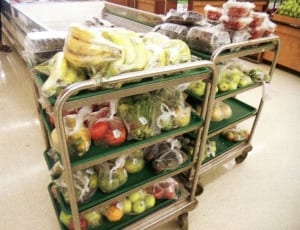One in two households earn less than a living wage in Perth & Huron. These photos, taken by residents, underline the impact of low incomes (Nov. 24, 2019)
I recently came across a report from the Social Research & Planning Council, a Division of United Way Perth-Huron.
At the above-noted link you can find short videos that complement the report.
The Social Research & Planning Council is funded by the City of Stratford, the County of Huron, County of Perth, and United Way Perth-Huron.
I originally came across the printed version of the above-noted report at the Stratford Public Library.

I shop at the Dollar Store a lot because it is within my budget. Source: Page 10, How Much Is Enough? (2019). Credit: Brianna
Many copies of the report, which I have read with much interest, were available at the library; I took a copy home with me. Some weeks later at the library, I came across a shorter, four-page version of the report.
On the first page of the shorter version you will find the statement: “1 in 2 households earn less than a living wage in Perth & Huron.”
The excerpts which follow below are from the 36-page, full version of the report, which you can access at the above-noted link.
At the end of the current post I share articles highlighting similar data regarding low-income jobs elsewhere.
2016 Census profiles
The report is entitled: How Much Is Enough? The Impact of Low Incomes on Households and Communities in Perth and Huron Counties.
The report notes (page 11) that based on 2016 Census profiles, “roughly half of households in Perth-Huron have a 2015 before tax income lower than $60,000.” [Canadian dollars.]
In the City of Stratford, the percentage of households earning less that $60,000 is 45 percent.
For Perth County, the percentage of household earning less than this amount is 42 percent.

This is a pair of shoes that have walked many miles. Source: page 16, How Much Is Enough? (2019). Credit: Warren
For Huron County, the percentage of households in this category is 46 percent.
For Ontario as a whole, the percentage is 40 percent.
I am impressed with the photos that accompany the report. Photography can serve so many useful purposes.

Asking for rides is my source of transportation. Source: page 18, How Much Is Enough (2019). Credit: Kassie
I’m aware, from my volunteer work focusing on community self-organizing, which I’ve been involved with for 30 years, that information by itself is not always the most effective way to reach an audience.
In the event community self-organizing is associated with efforts to change attitudes – for example, with regard to stereotypes associated with stigmatization regarding particular situations in life – public opinion research indicates that information-sharing by itself is in many cases not sufficient, by any means, to change attitudes.
Instead, storytelling often carries the message home, whatever the intended message may be, in a way that just sharing information, related to the message, is not likely to do.
In this case photography plays a key role in the storytelling associated with the report about low-income households in Perth and Huron. After I completed the current post I read the full report, as well as the shorter version of it, from front to back and have thought about what I have read. The shorter version, with a two-column format (which makes for easier reading) and icons made by Freepik from www.flaticon.com, summarizes the report really well.

How I live on less. 99 cents or less rack. You can eat healthy and make healthy choices for less. Source: page 20, How Much Is Enough? (2019). Credit: Joyce
Had I not seen the photographs, I perhaps would not have gotten around to such a reading task. Among other things, I am interested in the two pages of references, including many links, at the end (pages 35-36) of the document.
My purpose in writing the current post is to tell the story of the How Much Is Enough report by sharing photos from it.
Click on the photos to enlarge them.
Lived experience in photos: Photovoice Project
The text on page 6 of the report reads:
The Photovoice Project is photography taken by the community co-researchers of this report to demonstrate in a unique and impactful way what earning below the Living Wage can look like in Perth and Huron Counties.
The SRPC [Social Research and Planning Council] collaborated with local photographer, Terry Manzo, to offer photography workshops and mentorship to community co-researchers. Participants were then tasked with photographing their daily lives; showing how living on a low income affects their lives and giving participants a platform to share and express their experiences. Their photography is featured in the report with a quote authored by the co-researchers.
The sponsors for this project are the Huron Arts and Heritage Network, Huron County Health Unit, Huron-Perth Children’s Aid Society, and the Huron Collective Impact Summit.
Executive summary
An executive summary (pages 2-3) from the document reads:
This report builds upon previous research conducted in 2015 regarding the Living Wage in Perth-Huron. Focus groups were conducted in order to better understand the experiences of both individuals earning below a Living Wage and employers that may want to pay, or do pay, a Living Wage but face challenges in doing so. Data collected in the focus groups was combined with the results of conversations with local service providers to generate a community strategy.
The Living Wage is the hourly wage a worker needs to earn in order to cover their family’s basic needs. The calculation is based on a family of four with two adults working full-time at 35 hours per week. As of 2018, the Living Wage in Perth-Huron was calculated to be $17.44 per hour.[1]
To understand the effects of a Living Wage on families in Perth-Huron, participatory research was conducted with individuals who have lived experience of earning below a Living Wage and local employers over a series of eight focus groups.
Key findings from individuals with lived experience of earning below a Living Wage
Money stress is nearly ubiquitous among those earning below a Living Wage. Participants face persistent worry and uncertainty over their future.
Housing is the number one concern followed by bill payment.
Almost everyone can access food but the quality of that food is often poor.
Many people report health issues either caused or worsened by poor nutrition.
Transportation is a challenge in this community. When earning below a Living Wage, people most often walk or ask friends and family for rides.
Many people experience isolation as a result of being unable to afford transportation or recreation. However, many find comfort and friendship with others experiencing similar struggles.
Despite living through numerous challenges, many participants are able to cope with stress and maintain positivity by fostering relationships and taking life one day at a time.
Key findings from employers in Perth-Huron
Employers largely set wages based on education and experience but soft skills [that is, problem solving, communication, and motivation (mentioned at page 29); consistency, reliability, and problem-solving skills (referred to at page 30)] are also considered.
Employers in Perth-Huron struggle to fill positions. Many report a lack of skilled labour in the region and that many job applicants lack soft skills.
Many of the employers consulted recognize the challenges faced by employees and try to provide
informal benefits and accommodations whenever possible.
Employers have a largely favourable opinion of the Living Wage. Those who pay a Living Wage have benefited from decreased absenteeism, increased productivity, and the stability employees gain when they can afford their basic needs.
There are employers who want to pay a Living Wage but are limited in their ability to do so. For example, small retailers could only do so by raising prices and would no longer be competitive with online retailers.
Many employers want to bridge the gap between the minimum wage and the local Living Wage but large jumps in wages are difficult to implement. Slow and steady raises over several years are the most feasible way for employers to provide higher wages.

Keeps me busy and a donation to the hospital. Source: page 33, How Much Is Enough? (2019). Credit: Candice
Recommendation
The Social Research and Planning Council (SRPC) and United Way Perth-Huron (UWPH) should seek to engage with local municipalities, health units, Poverty to Prosperity (P2P) in Huron, Perth County Food Security Coalition, and other stakeholders through a collective impact approach to create a dual county strategy that reduces the impact of poverty inclusive of individuals and families who earn less than a Living Wage. A strategy, therefore, must be inclusive of approximately half of households in the region. Based on the findings of this report, the development of a Poverty Reduction Strategy needs to consider food security, transportation, income insecurity, housing, physical and mental health, social services, and challenges faced by employers including hiring, staff retention, and the business regulatory environment.
Conclusions
There is significant reason for optimism following discussions with those with lived experience of earning less than a Living Wage and employers. Both groups demonstrated significant empathy regarding the difficulties and constraints the other is dealing with and a desire to improve their shared situation. Those who earned less than a Living Wage reported significant motivation to learn, grow, and provide employers with the types of employees they seek. Likewise, employers demonstrated a deep and nuanced understanding of the benefits of providing employees with the stability and predictability that comes with a higher wage.
It should be emphasized that many earning below a Living Wage struggle. The daily human cost of the associated stresses and trade-offs is substantial and demands attention and resources. By working to steadily implement the recommendation provided while continuing to encourage a community- wide conversation about the Living Wage, UWPH can grow and strengthen the relationship between employees and employers to provide a higher quality of life for the community and its citizens.
Subsequent posts related to recent Huron-Perth report:
Additional articles regarding food banks and related topics
A July 24, 2019 CBC article is entitled: “Food bank map helps politicians see hunger in their own backyard: Feed Ontario’s new interactive map shows food bank use riding by riding.”
An excerpt reads:
He said another aspect of food bank use that the map made clear was that, although there are clients in every riding, some parts of Toronto are more at risk of food insecurity than others.
“You do see areas where there is virtually no food bank usage and areas of heavy concentration and those areas of heavy concentration might be in the centre of the city as they are and they might be in far reaches on the outskirts,” said Hetherington. “There is clearly a tale of two cities. There is clearly a divide.”
A Nov. 4, 2019 CBC article is entitled: “‘Troubling’ new numbers show food bank use on the rise in Toronto, Mississauga: Report links housing costs to food insecurity, says visits from Mississauga residents rose 16%.”
A Dec. 2, 2019 CBC article is entitled: “Ontario hunger report says 1 in 10 Ontarians can’t afford a basic standard of living: Those with employment accessing food banks has increased by 27 per cent.”
An excerpt reads:
In its report, Feed Ontario says that almost half of all minimum wage workers — who account for 15 per cent of Ontario’s work force — are above the age of 25, with one third of them holding a post-secondary degree and a half working full time. Part-time work has also increased.
Meanwhile, the number of temporary positions — such as “casual, seasonal, and contract roles” — has increased by 31 per cent since 1998.
These positions, Feed Ontario said, have lower compensation and make it difficult for individuals to build savings for a home or support a family.
A Dec. 3, 2019 London CTV article from Canadian Press is entitled: “Report finds Ontarians with full and part-time jobs increasingly using food banks.”
An excerpt reads:
The previous Liberal government increased the minimum wage to $14 an hour last year, with plans to boost it to $15. But the Progressive Conservative government scrapped those plans upon taking office last June and froze minimum wage until at least October 2020.
Feed Ontario’s Hunger Report found that labour laws governing access to employment insurance or workers compensation for injuries sustained on the job make it increasingly difficult to access those programs. As a result, it said a growing number of people are forced to rely on social assistance programs such as Ontario Works and the Ontario Disability Support Program.
Such initiatives provide an income that’s well below the poverty line, the report said, noting Ontario Works recipients take home just over $8,700 a year and those on ODSP are asked to survive on $14,000 annually.
Overall, the report found 71 per cent of households using food bank services rely on social assistance or government benefits as a primary income source.
It also found one third of food bank users were children under 18, and total visits climbed 4.2 per cent relative to the previous year.
Valarie Tarasuk, professor in the University of Toronto’s Department of Nutritional Sciences, said Feed Ontario’s findings paint only a partial picture of life for the working poor in Ontario.
“For every person that uses a food bank, we would say that there are four or five others in the community that are also struggling to put food on the table,” Tarasuk said. “Many of those will be people in the workforce.”
Low income jobs in United Kingdom
An April 9, 2018 London School of Economics article is entitled: “Long Read Review: The New Poverty by Stephen Armstrong.”
An excerpt reads:
One of the most revolting abuses of language in neoliberal Britain is the perpetual invitation to ‘have your say’. To ‘have your say’ is to replace democratic power with the expression of a consumer preference; you may say whether you approve or disapprove, whether you award a one-star or a five-star review of something that you had no input in making. There are a lot of people in Britain whose lives are difficult, EU or not – and whose lives have been getting more difficult regardless of the party in power. The Brexit referendum was a rare opportunity where ‘having a say’ could actually replace a miserable present with a future that was at least unknown. Armstrong finds plenty of racism and xenophobia among the poorest Britons. And yet, as he points out, some of the most ardent Leave voters live in communities with few immigrants or visible minorities. Armstrong finds inchoate anger, not ideology, among the alienated white working class.
Low income jobs in United States
A Dec. 2, 2019 CBS News article is entitled: “Almost half of all Americans work in low-wage jobs.”
An excerpt reads:
America’s unemployment rate is at a half-century low, but it also has a job-quality problem that affects nearly half the population, with a study finding 44% of U.S. workers are employed in low-wage jobs that pay median annual wages of $18,000.
Contrary to popular opinion, these workers aren’t teenagers or young adults just starting their careers, write Martha Ross and Nicole Bateman of the Brookings Institution’s Metropolitan Policy Program, which conducted the analysis.
Most of the 53 million Americans working in low-wage jobs are adults in their prime working years, or between about 25 to 54, they noted. Their median hourly wage is $10.22 per hour — that’s above the federal minimum wage of $7.25 an hour but well below what’s considered the living wage for many regions.
A Dec. 23, 2019 Brookings Institution article is entitled: “Poverty in America is rising. We need a plan to fight it.”
An excerpt reads:
These very real economic differences have enflamed the country’s existing racial and regional divides. But could they also be a rallying cry for people in poverty across the political spectrum? Instead of focusing on our divides, maybe researchers should emphasize how low-income Americans of all races, geographies, or parties share an economic fate—and should share an economic agenda.
Social determinants of health
An April 25, 2015 Toronto Star article about Toronto is entitled: “Economic inequality is bad for our health.”
An excerpt reads:
Over the past decade, health inequalities between the rich and the poor have persisted. In some cases, they have grown wider. In other words, opportunities to be healthy in the city of Toronto remain as unequally distributed as ever.
A Dec. 2, 2019 JAMA Network article is entitled: “Addressing Social Determinants to Improve Population Health: The Balance Between Clinical Care and Public Health.”
An excerpt reads:
Although the medical community’s embracing of social determinants of health is long overdue, programs that address the downstream health consequences of social adversities cannot be the principal strategy.
Kitchener
A Jan. 13, 2020 CBC article is entitled: “The system isn’t working’: Kitchener housing report raises red flags on affordability: Data gaps on housing speculation, ‘renovictions’ also highlighted.”
An excerpt reads:
Cooper said the uptick in housing prices is caused by a variety of factors:
– People fleeing the Greater Toronto Area in search of relatively greener pastures.
– More young people choosing to stick around after graduation
– New businesses setting up shop and bringing employees
– People buying real estate as an investment.
Although many of those factors are generally thought to be positive, they also contribute to an increase in housing costs.
“You see these results coming out for people not being able to afford to buy, not being able to afford to rent,” said Cooper.
“That’s why we say in the report that the system isn’t working.”
March 2020 Guardian article
A March 5, 2020 Guardian article is entitled: “The invisible city: how a homeless man built a life underground: After decades among the hidden homeless, Dominic Van Allen dug himself a bunker beneath a public park. But his life would get even more precarious.”
An excerpt reads:
He had a few thousand put away in the bank, and he could still take on handyman work, putting up shelves and assembling flatpack furniture for £20 or £30 a gig, often arranging these one-off jobs through an app on his phone. Knocked, tired, but still with a Crusoe spirit that never really left him, Van Allen bought good boots and a good tent and moved his life outdoors. Like a lot of people who drift into homelessness, the knack came piecemeal. Van Allen shaved his hair to a grade one, for easy cleaning with soap. He got to know which swimming pools had the cheapest one-off entry fees for showering; which drop-in centres let you use their address for post. He bought underwear and T-shirts in bulk, cheaply, online, so that these could be discarded if necessary – “crash and trash”, he called this. He became a regular at a Catholic church where they cooked a daily breakfast for the homeless.











A March 25, 2022 Stratford Beacon Herald article is entitled: “United Way report shows housing costs outpacing wages in Huron-Perth: A new report on the Future of Housing by the United Way Perth-Huron’s social research and planning council highlights the potential impacts of housing-cost increases continuing to outpace wage increases in Perth and Huron counties.”
An excerpt reads:
Since many residents of Perth and Huron counties can’t afford to purchase a detached home at that average price while more attainable or affordable housing options are harder to find, Lamport-Lewis said local employers are having a harder time attracting and retaining workers to the region.
Without that workforce, she said the region could become less attractive to new industry and business, which could lead to area municipalities losing out on much-needed tax revenue to support the health and social services the large and growing population of Perth-Huron residents aged 65 and older need.
With so much at stake, the authors of the Future of Housing report included a number of recommendations and solutions with their findings.
“There’s a lot of opportunities for living-wage employers to step into the ring. We’re looking at education and awareness around sort of the changing merit of housing. We need all types of housing, not just the single-detached home anymore. We also need to maybe utilize the not-for-profit housing corporation because they’re focused on affordable and attainable housing (and) we really need to look at strategies for retention of the workforce,” Lamport-Lewis said.
In addition to providing area municipalities with the information they need to address the housing crisis locally, Lamport-Lewis said she hopes the report will serve to educate the general public around the need for all styles of housing in their communities.